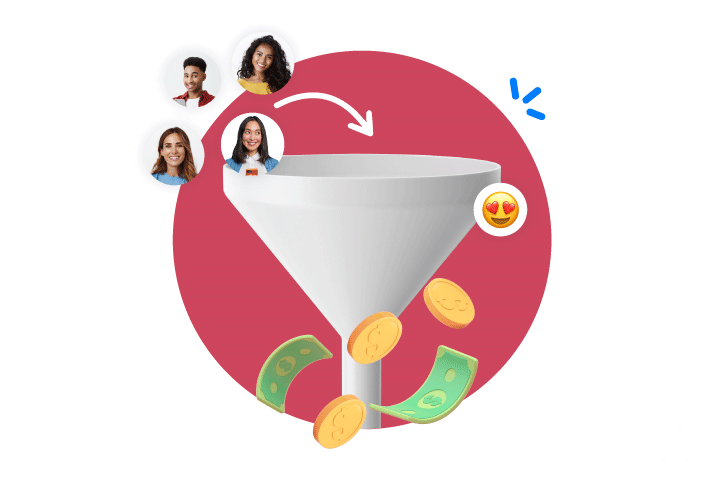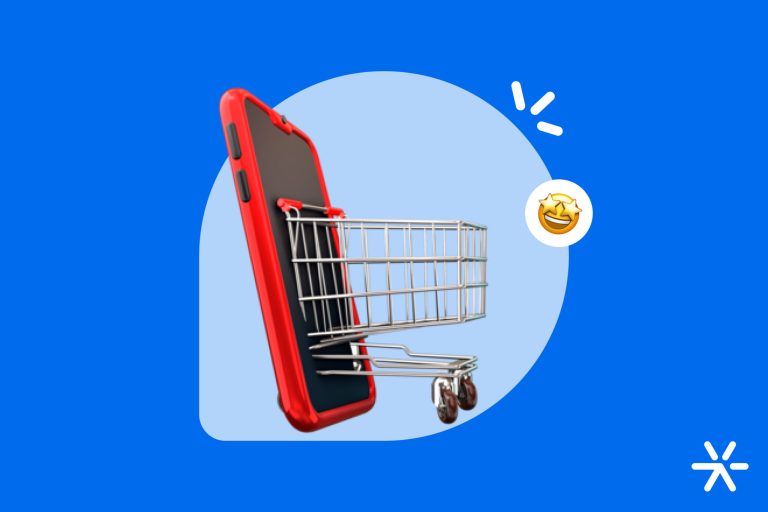15 Inconvenient Truths About Lead Generation
Lead Generation Is the Top Concern for Marketing Professionals and Managers — According to Themselves
When asked about their yearly goals for the “State of Marketing” report (HubSpot), the most common answer — chosen by around 35% of respondents — was that their priority is generating qualified leads.
Qualified lead generation is essential for sales results, and here on the blog, we already have several articles on the topic.
Today, we’ll cover some aspects of this process that not everyone talks about — because they’re not exactly what you want to hear.
So, gather your courage and keep reading this article!
What Is Lead Generation?

Generating new leads is directly linked to creating business opportunities and expanding prospects for your company’s marketing and sales teams.
Lead generation enables companies to acquire personal information from people who are potential customers — and the best part is that this data is voluntarily provided by the consumers themselves, establishing a relationship of trust between the person and the brand.
How to Generate Leads?
When someone provides their contact information to your company, it shows they’re interested in something you’re offering. But that doesn’t always mean the person is ready to buy.
That’s why you must create hooks and lead generation offers tailored to different stages of the marketing and sales funnel. This way, people with various levels of buying readiness will feel compelled to share their contact info with you.
There are many tools you can use to generate leads, such as landing pages, forms, eBooks, webinars, podcasts, conversational marketing tools, surveys, free trials, special offers, and more.
Let’s explore some of these tools below.
What Are the Main Tools for Lead Generation?

Website Builders / Landing Pages
A landing page is a web page designed with a single, focused purpose. According to research from Marketo, 68% of companies develop lead generation strategies using landing pages.
Also known as capture pages, they’re often used to offer valuable materials such as eBooks, infographics, webinars, courses, or demos. The possibilities are many — and your brand collects lead information in exchange for that value.
You can also use complementary tools like static forms and pop-ups, which follow the same lead generation logic.
Site or landing page builders are tools that help your company craft customized strategies, adjusting layout and content according to your brand’s goals.
Email Automation Tools
If you already have a contact database, you can generate and qualify leads from it.
To nurture captured leads, build a strategy and design a flow that guides them from their first interaction with your brand to the purchase or contract closing stage.
It’s also important to think about post-sale actions to maintain customer relationships and encourage repeat purchases.
You should define the best formats and channels for each phase of the customer journey.
Using marketing automation platforms makes this process much more efficient.
Online Chat / WhatsApp Button / Call Now
A more modern and attractive alternative to static forms is offering fast and personalized service — which is exactly what today’s consumers expect.
Tools like live chat, WhatsApp buttons, and call options can help you generate leads.
But keep in mind: these tools only work during business hours when you have staff available to respond. That can frustrate some potential customers who are browsing outside of regular hours.
Conversational Marketing Tools
An alternative to the tools above — one that doesn’t require human agents — is conversational marketing.
These tools offer a more dynamic and personalized way to engage visitors than static forms.
In fact, a lead is nine times more likely to convert if they receive a reply within five minutes (source: InsideSales.com). Automated communication can help make that happen.
Conversational marketing encompasses tools and actions related to real-time conversations and is one of the most scalable, modern approaches to lead generation.
It can be implemented using technologies such as chatbots and virtual assistants.
Ad Platforms
Besides using ads to drive traffic to your site or landing pages, many ad platforms now allow you to generate leads directly — without users leaving the channel they’re browsing.
Popular platforms like Facebook Lead Ads, LinkedIn Lead Gen Forms, and Google Ads Lead Form Extensions support this functionality.
Online Events
Especially in the B2B sector, even offline events remain an effective method for generating leads. A 2018 study by Marketing Charts showed that events are the top source of leads for this market.
With the pandemic still affecting 2021, another option was to host online lead generation events that required registration — such as webinars and virtual conferences.
This strategy saw a massive boom during the social isolation period.
Social Media
Beyond paid social media ads, you can create organic posts that direct users to key landing pages — generating traffic from people who already engage with your brand.
According to the “State of Marketing” report (HubSpot, 2021), social media was the most used channel for marketing strategies that year.
And not just for engagement: many companies are generating qualified leads through social media. In fact, the same HubSpot report listed it among the channels delivering the highest ROI for businesses.

15 Inconvenient Truths About Lead Generation
Sure, you’ve probably already read and heard a lot about lead generation and how to do it. But there are some points that few articles address. Do you know what they are?
Let’s answer that question by presenting some truths about lead generation that you may not want to hear.
But believe us — understanding these truths is key to generating high-quality leads that actually deliver results for your company.
1. You’ll Have to Invest (Heavily) Before You See Any Return
You might think generating new contacts isn’t that complicated.
And yes, there are many ways to generate leads. But generating qualified leads that truly convert into sales is another story — and it does require a significant upfront investment.
In fact, 53% of marketing managers spend at least half of their budget on lead generation (source: BrightTALK).
Don’t fall for tools or companies that promise a flood of leads with minimal investment. You’ll likely end up with purchased mailing lists that are virtually useless.
To truly benefit from lead generation, invest in qualified professionals, time, services, and robust tools.
2. More Leads Doesn’t Necessarily Mean More Sales
This may be disappointing, but you need to understand that generating a high volume of leads doesn’t automatically translate into increased sales.
There’s a big difference between simply generating leads and generating qualified leads — people who actually fit your target audience, have the purchasing power, and are at the right stage of the buyer’s journey.
Your brand may generate a ton of contacts that never end up buying anything — and that number can reach up to 79% of your entire database (source: Next Leap Strategy).
In fact, the more leads you generate, the lower your conversion rates tend to become. That’s why lead nurturing is so important.
3. Testing Is Essential — and That Requires Time and Investment
Lead generation doesn’t follow a one-size-fits-all formula.
Let me know if you’d like the full translation continued from point 3 onward or if you’d like this converted into a downloadable format like PDF or PowerPoint.
Many factors influence what works and what doesn’t: your market, your audience’s consumption habits, the channels you choose, the type of offer used as a conversion hook, among many other aspects.
Moreover, in a market that changes so quickly, a strategy that works today probably won’t work the same way in two years.
That’s why one of the most important things in lead generation is to stay in constant motion—testing new strategies, closely monitoring your audience, analyzing results…
And of course, this requires time and investment.
4. Regardless of Media Investment, If Your Website Isn’t Good, Leads Won’t Convert
You’ve figured out what works with your audience and tested the best ad options. You’re getting good results and driving qualified traffic to your site—but your conversion rates are still low.
The problem might be your website.
A bad website—unattractive, unclear about your brand’s value proposition, or lacking compelling conversion hooks—won’t push visitors to take the next step.
Invest in the user experience on your website. Make it easy for visitors to find the information they want, be clear about the benefits they’ll receive, use social proof, and streamline the conversion process.
5. If You Target the Wrong Audience, You’ll Generate Many Leads but No Sales
You might have nailed the campaign ads—great copy, compelling visuals—and are generating more leads than ever!
But if you’re attracting the wrong audience, even if they become leads, they won’t move through the marketing funnel to reach the purchase stage.
Or worse, they might become a churn risk, turning into a headache for your business.
This doesn’t necessarily mean your nurturing or qualification strategies are wrong. It could simply be that the leads are not the right ones.
Generating qualified leads begins with attracting qualified traffic. For example, let’s say your company offers a local service, operating only in your city.
If you don’t target your campaign properly, you’ll end up generating leads from regions your company doesn’t serve. That’s why proper segmentation in paid media campaigns is essential.
6. Weekly Check-ins With Your Sales Team Are Essential (Even if You Don’t Like It)
Some marketing and sales teams resist working together—or even if there’s no active resistance, each team focuses only on its own results.
In reality, integration between marketing and sales teams is essential, as they share the same end goal: bringing in new customers and revenue for the company.
7. Without a Lead Nurturing Strategy, You’ll End Up With Hundreds of Leads Sitting Idle
You’ve attracted qualified traffic and leads that seem like a great fit for your business strategy. That’s just the first part of the battle.
Don’t expect them to magically become customers. And hitting them with a sales pitch right away may actually push them away.
You need to prepare them for the purchase moment, and this is done through lead nurturing.
Nurtured leads generate 20% more sales opportunities and spend, on average, 47% more than non-nurtured leads. Are those numbers enough to convince you?
8. Email Marketing Is a Science—But Not an Exact One
“This last email campaign had amazing results—I’ll just repeat the formula and keep getting great results, right?”
Actually, no. 😶
Even if one email campaign performs well, reusing the same strategy won’t guarantee the same outcome.
Let’s say you created a successful middle-of-the-funnel (MoFu) nurturing campaign that strengthened relationships with your leads and helped move them forward.
That’s great—but will the same campaign format, slightly tweaked, work for top- or bottom-of-funnel leads? Probably not.
This doesn’t mean you should throw every campaign away after one use—you can reuse insights or snippets of copy—but remember: every campaign is unique, and experimentation is the key to successful email marketing.
9. Publishing a Lot of Articles on Your Blog Doesn’t Guarantee More Leads
Quantity isn’t quality.
Posting dozens of articles on your blog without proper research or planning won’t deliver results—in fact, it will likely just waste your time and effort.
Think about it: if your market segment is highly competitive, chances are other blogs have already been producing content for years and have strong authority.
It’s better to create fewer but more structured articles, with deeper insights and better sources, exploring topics your competitors haven’t yet covered.
And of course, do proper keyword research to find terms with good monthly search volume but lower competition.
🔎 Also read: Blog for Lead Generation: 10 Essential Strategies
10. What Works Today May Not Work Tomorrow—Lead Generation Must Be Diversified
We know things are constantly changing, especially in the digital world.
For example, some Google algorithm updates have significantly affected blogs and content creators for months, with slow recovery.
Now we’re also facing the end of third-party cookies, which will make it harder for companies to deliver personalized user experiences.
That’s why, in addition to staying alert to changes, you need to spread your lead generation efforts across multiple fronts.
11. There’s a Formal A/B Testing Method That Few People Actually Use
Perseverance and experimentation are key when it comes to this 11th truth. And this is exactly what A/B testing is about.
Only through testing can you truly understand what’s working (or not) on your lead generation pages.
There are several proven elements you should test, such as:
- Images
- Copy
- Pop-ups
- Headline
- CTA
- Page traffic
- Page design
- Page load speed
- Emails
If you’re just starting out with A/B testing, use Google Optimize. It allows you to create tests quickly and easily.
But act fast—this tool is being discontinued by Google. As of September 2023, Google Optimize will no longer be available.
12. Any Top-of-Funnel Content Without Keyword Research Relies on Luck to Generate Leads
Top-of-funnel content is your business’s hook.
But this kind of content is especially challenging: competition is fierce, and since it’s mainly informational, there’s a long journey ahead before a reader becomes a customer.
That’s why a top-of-funnel content strategy must be carefully planned and based on thorough keyword research—especially in competitive markets with experienced players.
Here’s how it works: start by listing potential topics—things your customers frequently ask about. Then, input those topics into keyword research tools like Google Keyword Planner, Ubersuggest, or Semrush.
These tools will return the search volumes for each topic. Those are your keywords!
13. Every Audience Has Specific Preferences for Materials That Drive Conversion
You’re not like everyone else—and neither is your audience.
Not all audiences will respond well to the old combo of blog + ebook + infographic.
We’re seeing a trend toward engineering as marketing—real tools that make a difference in your leads’ lives.
Example: if you’re a digital marketing agency, maybe you share a spreadsheet every week with high-performing email subject lines.
Or you offer a bundle of rejected Reels scripts that you were going to discard anyway.
The key is to offer real tools—things your leads will actually use. This converts far better than traditional e-books.
🔎 Also read: ICP, Persona, and Target Audience: Don’t Confuse These 3 Concepts
14. You Need to Be Prepared for a Sudden Spike in Lead Generation
You could go viral at any moment. 🤯
When I say “go viral,” I mean you might experience a sudden lead generation boom. Are you ready for that?
We know lead generation is the result of continuous effort, but sudden spikes happen quite frequently.
Maybe a particular piece of content starts performing better, some articles start ranking well on Google, or even a YouTube video gets a lot of views. Just like that—you’ve generated 5x more leads from one month to the next.
And the reasons are endless: maybe someone said something on a TV show and people started searching for it. Maybe it’s a seasonal topic that gains traction this time of year. And so on.
As great as it is to generate more leads, you need to have a plan for what to do and how to handle that influx.
Are your automations and nurturing flows running properly? Do you have emails ready for the persona that’s converting? Are the articles generating leads up to date? Is your sales team prepared to handle the increased demand?
These are just a few of the questions you need to ask yourself. And the answer to all of them should be a resounding yes!
15. New Tools Can Transform Your Lead Generation Overnight
There are some tools that can transform your lead generation quickly—some literally overnight.
But to keep you from feeling discouraged by all these inconvenient truths that might leave you with more questions than answers, here’s a tool that can actually transform your lead generation, increasing your conversion rate by up to 3 times!
I’m talking about Leadster’s conversational marketing platform, which uses a chatbot for sales and marketing to deliver personalized prompts that grab the user’s attention, collect their data, and automatically qualify them.
In other words, by the time the lead reaches your sales team, you’ll already know exactly what to do with each one.
Try it out now!
Conclusion
We know that some truths can hurt, but they’re far more useful in building a strong lead generation strategy than “comfortable lies.”
Want to share some other inconvenient truths you’ve discovered along the way? Leave a comment!







